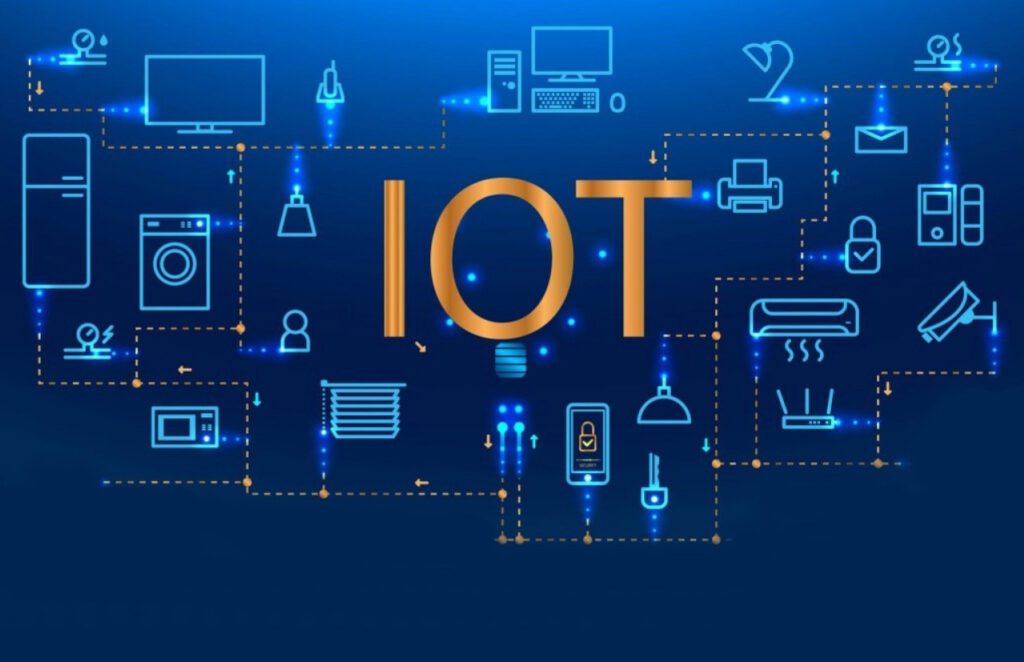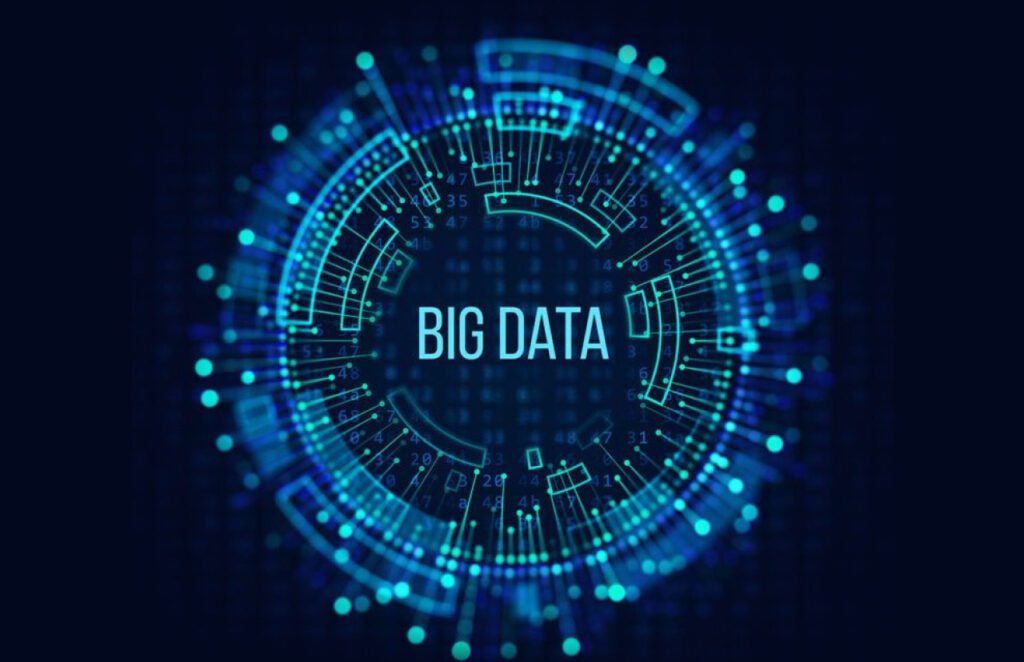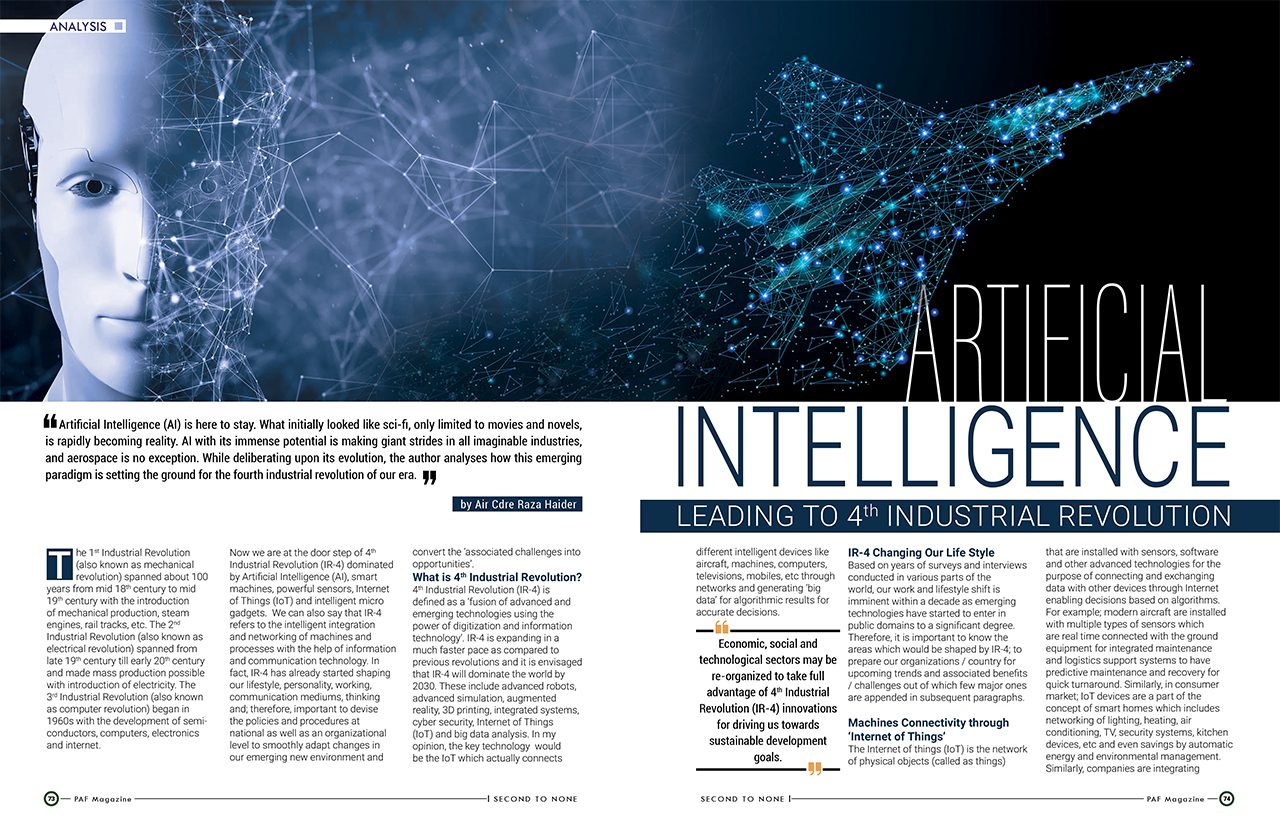Artificial Intelligence (AI) is here to stay. What initially looked like sci-fi, only limited to movies and novels, is rapidly becoming reality. AI with its immense potential is making giant strides in all imaginable industries, and aerospace is no exception. While deliberating upon its evolution, the author analyses how this emerging paradigm is setting the ground for the fourth industrial revolution of our era.
The 1st Industrial Revolution (also known as mechanical revolution) spanned about 100 years from mid 18th century to mid 19th century with the introduction of mechanical production, steam engines, rail tracks, etc. The 2nd Industrial Revolution (also known as electrical revolution) spanned from late 19th century till early 20th century and made mass production possible with introduction of electricity. The 3rd Industrial Revolution (also known as computer revolution) began in 1960s with the development of semi-conductors, computers, electronics and internet.
Now we are at the door step of 4th Industrial Revolution (IR-4) dominated by Artificial Intelligence (AI), smart machines, powerful sensors, Internet of Things (IoT) and intelligent micro gadgets. We can also say that IR-4 refers to the intelligent integration and networking of machines and processes with the help of information and communication technology. In fact, IR-4 has already started shaping our lifestyle, personality, working, communication mediums, thinking and; therefore, important to devise the policies and procedures at national as well as an organizational level to smoothly adapt changes in our emerging new environment and convert the ‘associated challenges into opportunities’.
What is 4th Industrial Revolution?

4th Industrial Revolution (IR-4) is defined as a ‘fusion of advanced and emerging technologies using the power of digitization and information technology’. IR-4 is expanding in a much faster pace as compared to previous revolutions and it is envisaged that IR-4 will dominate the world by 2030. These include advanced robots, advanced simulation, augmented reality, 3D printing, integrated systems, cyber security, Internet of Things (IoT) and big data analysis. In my opinion, the key technology would be the IoT which actually connects different intelligent devices like aircraft, machines, computers, televisions, mobiles, etc through networks and generating ‘big data’ for algorithmic results for accurate decisions.
IR-4 Changing Our Life Style
Based on years of surveys and interviews conducted in various parts of the world, our work and lifestyle shift is imminent within a decade as emerging technologies have started to enter in public domains to a significant degree. Therefore, it is important to know the areas which would be shaped by IR-4; to prepare our organizations / country for upcoming trends and associated benefits / challenges out of which few major ones are appended in subsequent paragraphs.
Machines Connectivity through ‘Internet of Things’
The Internet of things (IoT) is the network of physical objects (called as things) that are installed with sensors, software and other advanced technologies for the purpose of connecting and exchanging data with other devices through Internet enabling decisions based on algorithms. For example; modern aircraft are installed with multiple types of sensors which are real time connected with the ground equipment for integrated maintenance and logistics support systems to have predictive maintenance and recovery for quick turnaround. Similarly, in consumer market; IoT devices are a part of the concept of smart homes which includes networking of lighting, heating, air conditioning, TV, security systems, kitchen devices, etc and even savings by automatic energy and environmental management. Similarly, companies are integrating their products with cars for automatically turning up the heaters in snowy countries just short of reaching home.
Big Data Analytics for Decision Making
Data is increasing day by day (getting double every 1.2 years) and organizations are working to develop algorithms to utilize their data for accurate decision making. Big data is a field to analyse methodically extract information through prognostics or analytical formulas from data sets that are too large to be dealt through traditional data-processing software. The term big data also tends to refer to the use of predictive analytics and user behaviour analytics to extract value from data. In case of aviation, big data possesses a lot of utility by converting aircraft and associated equipment data to Big Data for analytics and subsequent utilization in maintenance and operations.
Microchips in Humans
People are getting more and more dependent on gadgets and connected devices for communication, location, health, etc. Old examples are heart pacemakers or acoustics implants and trials are in progress for implantable nano-chips (RFIDs). It is envisaged that nano-chips would be implanted inside every human body in future; to serve as identity cards or passports, mobile phones, brain waves readers, healing medicines, password, logon to mobile or computers, etc. For example; as a trial, chips are inserted in hands of individuals between forefinger and thumb to open secure elevators, doors, unlock mobile phone / laptops and store digital business cards. Similarly, health monitoring is under trial by sending “smart dust” of sand grain size inside body which may detect, record and transmit health information to medical monitoring centres for predictive actions.

Individual Presence on Internet
Today 4.57 billion people (60% of the world) are active internet users and connected to the internet. In future, internet access and wifi would not only be a luxury but a basic right of people like electricity or water and would be available to the complete globe. With it s growing influence on individual consumers and large economies alike, the internet has become an increasingly vital part of our day-to-day lives. While it may have many positive outcomes, digital presence would have its own challenges as it possesses remarkable linkages with daily lifestyle. Building and managing digital relations would be a social challenge especially for children when they would be sharing ideas and seeking guidance from strangers (instead of parents/family), find and be found and maintain virtual contacts throughout the world.
Super Computer on your Mobile
Today’s smart phone possesses more computing power than former super computers of room size and is actually a super computer in our pocket. Currently, 3.5 billion (45%) of world population using smart phones and expected to keep growing @ 9 percent per year and would hit 7.2 billion by 2023. Over time, smart phones have replaced laptops as phones getting smarter day by day. It makes sense that smart phones will now serve as our primary computing devices in future; as performance gap between smart phones and laptops keeps widening and users upgrade their smart phones at a faster rate than their notebook PCs.
3D Printing
3D printing or additive manufacturing is a process of creating object by layer to layer printing from a 3D CAD model. 3D printer is fast and economical as compared to traditional manufacturing of ‘removing layers’ instead of ‘additive layers’ and has a capability of making more complex models with simple equipment. For example, in health sector; 3D printing can make tailor-made human parts through a process known as bio-printing and first use of 3D printed spine was done in 2014 to replace cancerous vertebra in neck with new vertebra; which was modeled from original vertebra of patient.
IR-4 in Aircraft Predictive Maintenance
Generally, there are two types of maintenance which are followed in the aviation world. Unscheduled maintenance which is carried out once item has malfunctioned and scheduled maintenance which is based either on calendar or hours of operations, calculated on the basis of statistics or MTBF of components.
In IR-4, concept of ‘AI based networked predictive maintenance’ emerged with the advent of artificial intelligence and big data. In this concept, monitoring of aircraft parameters is carried out through sensors using real time data for condition-based maintenance instead of scheduled / preventive maintenance. Moreover, AI based maintenance can also have following additional advantages:
- AI based maintenance not only enhanced flight safety, aircraft availability and cost effectiveness but also leads to accurate defect trends, procurements and budgeting.
- Big data results can enable the maintenance crew to make data driven decisions instead of individual decisions.
- AI based maintenance provides individual aircraft tracking and fleet health by providing quantitative information like sorties, inspections, components tracking, configuration management, upgrades, etc.
Way Forward
We cannot deny that we are at the beginning of Industrial Revolution-4. Stephen Hawking said ‘Whereas the short-term impact of AI depends on who controls it, the long-term impact depends on whether it can be controlled at all’. IR-4 impacts will ultimately be determined by our ability and efforts to tailor it in a way to safeguard our interests. In this regard, under mentioned are few recommendations as a way forward:-
- IR-4 ‘challenges’ may be first ‘identified’ and subsequently transformed into ‘opportunities’ by ascertaining IR-4 effects and impacts in future.
- Awareness and understanding in all public and private sectors of Pakistan may be enhanced through syllabus reviews at educational / training institutes.
- Economic, social and technological sectors may be re-organized to take full advantage of IR-4 innovations for driving us towards sustainable development goals.
- Due to high trend of data-intensive technologies in defense, education, health, media, sports, agriculture and industries, ‘Big Data’ analysis field may be promoted in Pakistan owing to rising demand of Information management specialists in future.
A comprehensive policy may be developed at national and organizational levels to shape IR-4 for coming generations.








